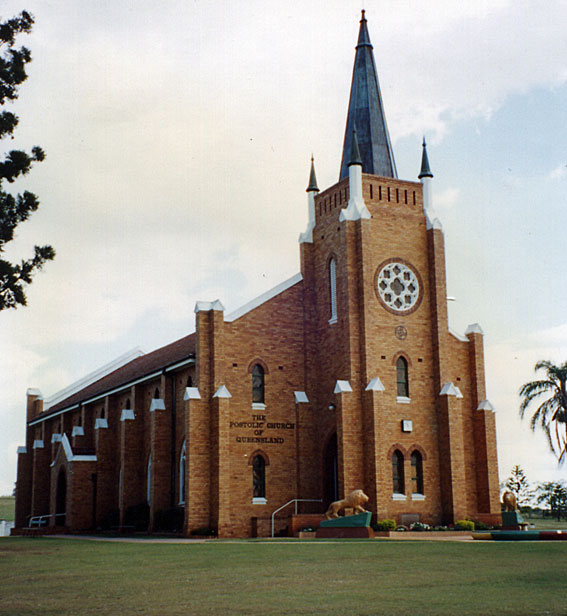
The Apostolic Cathedral, Hatton Vale
[Photograph by Howard Baker (1990s)]

The Apostolic Cathedral, Hatton Vale
[Photograph by Howard Baker (1990s)]
Historical and Technical Documentation by Geoffrey Cox
© OHTA 2011, 2015 (last updated May 2015)
Hatton Vale is a rural town situated some 20km east of Gatton on the Warrego Highway. German settlers began farming in the area in the 1870s.
The Apostolic Church had been established early in the nineteenth century, initially in England and subsequently in Germany. It came to Australia in 1883 when Heinrich F. Niemeyer settled in Queensland. The Hatton Vale community was the first community of the Apostolic Church established in Australia.

Memorial to H.F. Niemeyer inside the church
[Photograph by Geoffrey Cox (September 2014)]
The first church building at Hatton Vale was dedicated in 1889 and extended in 1926. The brick Cathedral, designed by the renowned architect Dr Karl Langer, was opened in 1950.1
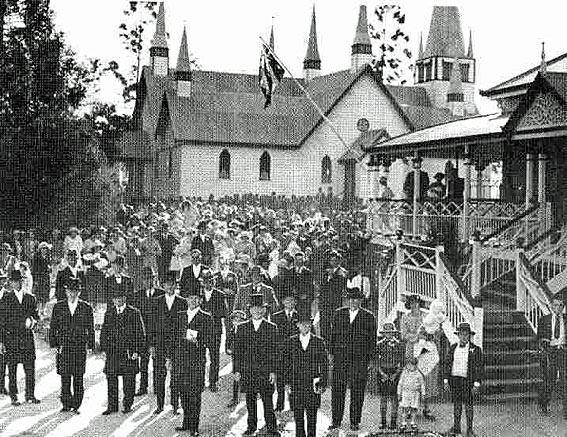
The Hatton Vale church and members celebrating 50 years in Australia (1933)
[Photograph from 'The Apostolic Church of Queensland: A Brief History and Profile of our Church' -
http://www.apostolicchurchqld.org.au - accessed November 2011]
In 2001-04, the precinct was extended with new openings in the side walls of the 1950 brick building, linking it to an expanded worship space and other amenities. The project was designed by KaddatZ Architects of Tabletop, Withcott, Queensland, and received high commendation from the Royal Australian Institute of Architects.2
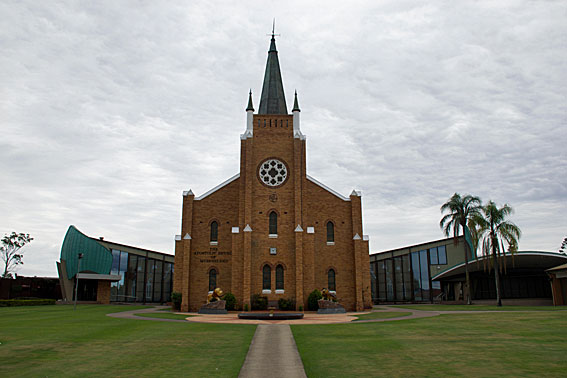
The expanded building, with extensions by KaddatzZ Architects
[Photograph by Rodney Ford (September 2014)]
First Organ (previous church).
A 'pipe organ' is reported to have been installed in the first church in 1896, and was still in use at the time of the Golden Jubilee of the church in 1933.3 No details of this instrument appear to have survived, and it may have been a harmonium. There is no record of maintenance for an instrument in this location in the Whitehouse Bros ledgers.
Present Organ.
The present organ was installed in November 1950 by Whitehouse Bros of Brisbane at a cost of £831.5.0.4 It incorporates the case, console, soundboard and action of the B.B. Whitehouse & Co. organ built in 1911 for the Methodist Church, Wooloowin, together with pipework from the Thomas Jennings organ installed originally at All Saints' Anglican Church, Wickham Terrace, Brisbane in 1863.5
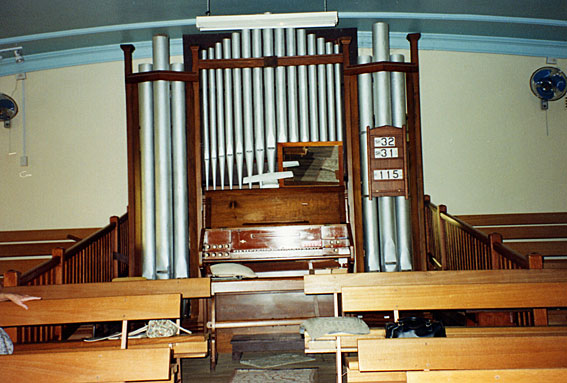
The case and console of the B.B.Whitehouse & Co. organ (1911)
with pipework from the Thomas Jennings organ (1863)
[Photograph by Howard Baker (1990s)]
The Wooloowin organ had been completely rebuilt with pneumatic action and enlarged to two manuals in 1948, retaining only the pipework of the original instrument. Apart from the pipework, therefore, the Wooloowin organ itself was available for re-deployment at Hatton Vale. The pedalboard was removed, although the draw-stops for the Bourdon 16ft and a 'Manual to Pedal' coupler were retained on the console.
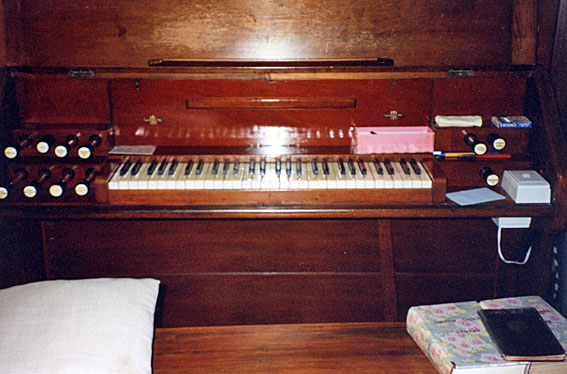
Console of the B.B.Whitehouse & Co. organ (1911)
[Photograph by Howard Baker (1990s)]
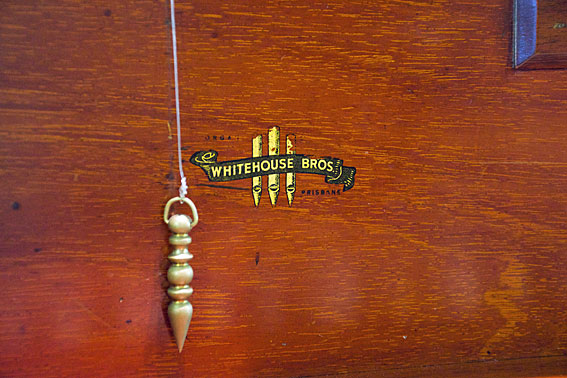
Whitehouse Bros transfer and telltale on the 1911 console
[Photograph by Rodney Ford (September 2014)]
The original manual soundboard had allowed for six stops, including two divided ranks (originally Gedact 8ft and Closed Horn 8ft),6 and this was filled with replacement pipework from the Jennings organ, which had been in storage since 1939 in a house at Nundah in Brisbane.7
The specification, as recorded in 1973, was as follows:
| MANUAL Open Diapason Stopped Diapason Bass Stopped Diapason Treble Dulciana Bass Dulciana Treble Principal Flute Fifteenth COUPLER Super Octave |
8 8 8 8 8 4 4 2 |
Mechanical action
Draw-stop console
Divided stops split at e'/f'
Compass: 58 notes
2 composition pedals
Lever-swell pedal.8
Substantial maintenance on the instrument was undertaken in 2004 by W.J. Simon Pierce, including replacement of puffers on the façade pipes and re-leathering of bellows.9 The instrument was enlarged in 2008 by W.J. Simon Pierce, who enlarged the original manual soundboard to accommodate four new stops (including an additional divided stop), and added a new pedalboard with Bourdon 16ft extended mechanically to Bass Flute 8ft. The divided stops were made to operate on single draw-stops, which engage only the treble of the rank when half-drawn, and the entire rank when drawn fully. This enables a Sesquialtera or Trumpet to be available for right-hand solos. The action was re-designed using aluminium wire, and the pipes in the two towers (not originally intended for this case) were raised to provide a better proportioned appearance.10

The enlarged B.B.Whitehouse & Co. organ,
with re-proportioned façade pipes
[Photograph by Geoffrey Cox (September 2014)]
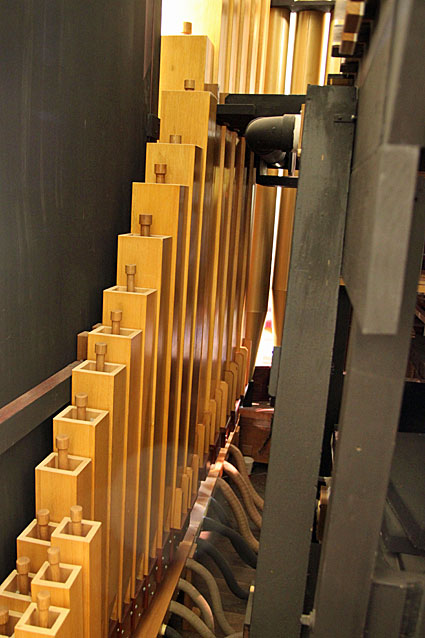
Pipes of the Pedal Bourdon added in 2008
[Photograph by Peter Robinson (September 2014)]
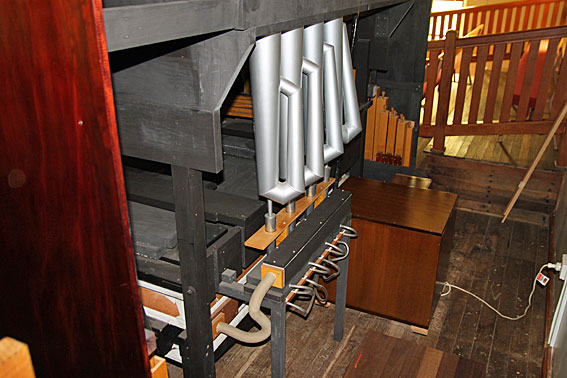
The longest knuckled pipes of the Trumpet,
placed on a pneumatic offnote chest to the rear of the Swell box
[Photograph by Peter Robinson (September 2014)]

The organbuilder's nameplate, 2008
[Photograph by Geoffrey Cox (September 2014)]
| MANUAL Open Diapason Stopt Diapason Dulciana Principal Flute Twelfth [divided] Fifteenth Tierce [divided] Mixture Trumpet [divided] COUPLERS Super Octave Manual to Pedal PEDAL Bourdon Bass Flute |
8 8 8 4 4 2-2/3 2 1-3/5 III 8 16 8 |
A A |
[2008] [2008] [2008] [2008; ex 'Cornopean' from Uniting (Presbyterian) Church, Waverley, NSW] [2008] [2008] [2008] |
Mechanical action
Draw-stop console
Compass: 58/30
2 composition pedals
Balanced swell pedal [2008].11
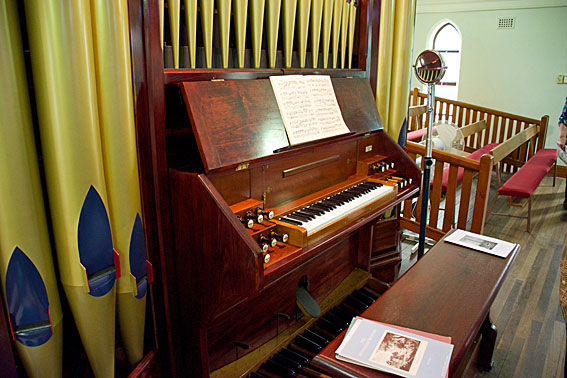
Console of the enlarged organ
[Photograph by Rodney Ford (September 2014)]


Stop jambs of the enlarged organ
[Photograph by Geoffrey Cox (September 2014)]
The instrument is situated in a large rear gallery, and is served well by the acoustics of the building.
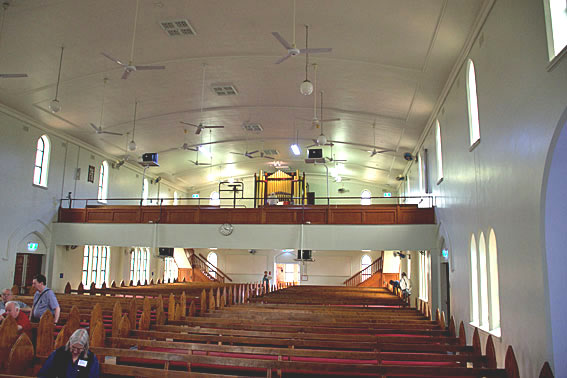
Interior of the Apostolic Cathedral, Hatton Vale
[Photograph by Rodney Ford (September 2014)]
____________________________________________________________________
1 The Apostolic Church of Queensland and Hatton Vale Community Centenary, 1883-1983: History and Souvenir Booklet (privately printed, [1983]), pp. 3, 19-22. See also: Howard Baker, 'Notes, Quotes and Anecdotes,' The Organ Voice, vol. 22, no. 1 (Autumn 1996), p. 47.
2 KaddatZ Architects, 'Projects: Hatton Vale Cathedral' at http://www.kaddatzarchitects.com.au - accessed November 2011.
3 The Apostolic Church of Queensland, op. cit., pp. 19, 21. The reference on p. 19 (dating from 1933) is to 'an organ', which becomes 'a pipe organ' on p. 21 (dating from 1983).
4 Whitehouse Bros Ledger (1940-1954), p. 450.
5 Personal communication to G. Cox from Mr J.H. Whitehouse, c.1974.
6 see: Uniting Church, Cleveland.
7 see: All Saints' Anglican Church, Brisbane.
8 Specification noted by G. Cox, 1973. Howard Baker's specification given in The Organ Voice, vol. 22, no. 1 (Autumn 1996), p. 49 includes the non-operating stop-knobs from the old organ, and his reference to 'swell pull-down' apparently refers to the lever-swell pedal.
9 OHTA News, vol. 29, no. 2 (April 2005), p. 9; The Organ Voice, vol. 31, no. 4 (December 2004), pp. 13-14.
10 Simon Pierce, 'The Organ of the Apostolic Cathedral, Hatton Vale,' Organ Australia, vol. 5, no. 1 (March 2009), pp. 28-29.
11 Specification noted by G. Cox 2014, and from Pierce, op. cit., p. 29, and personal communication to G.Cox from John Maidment, March 2014.